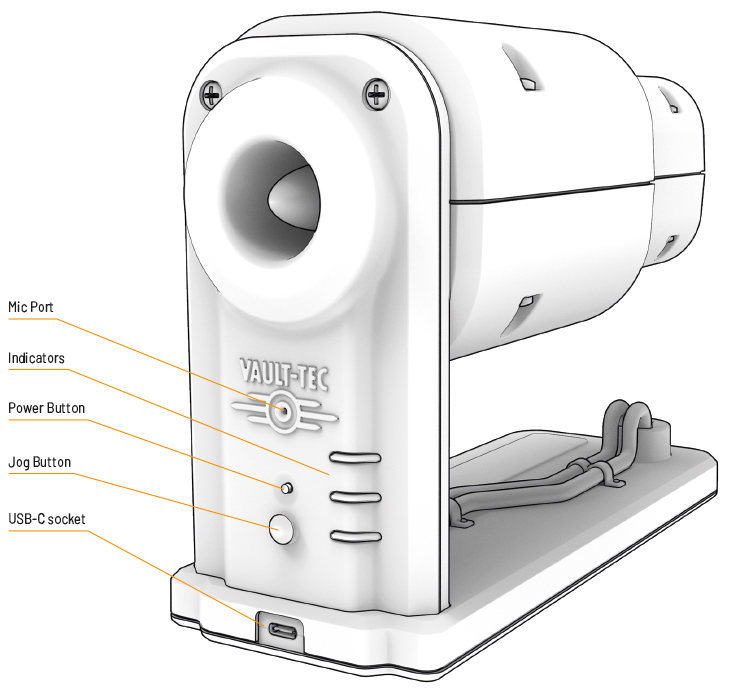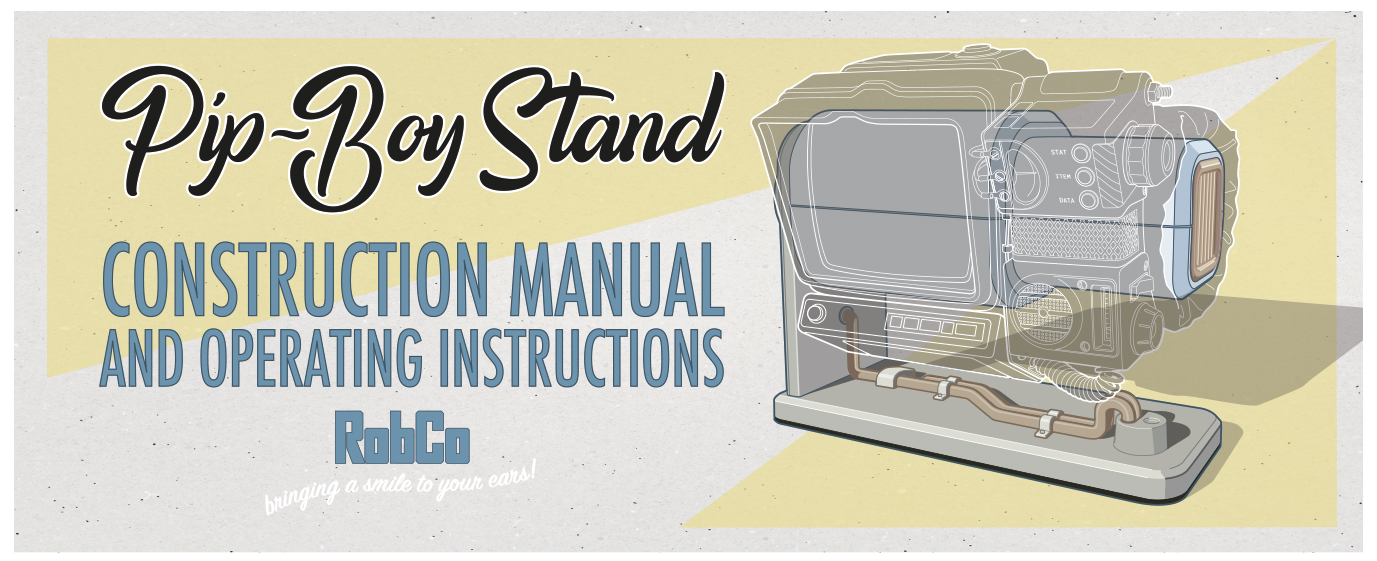
Click here to download a PDF of this manual in printer friendly format.
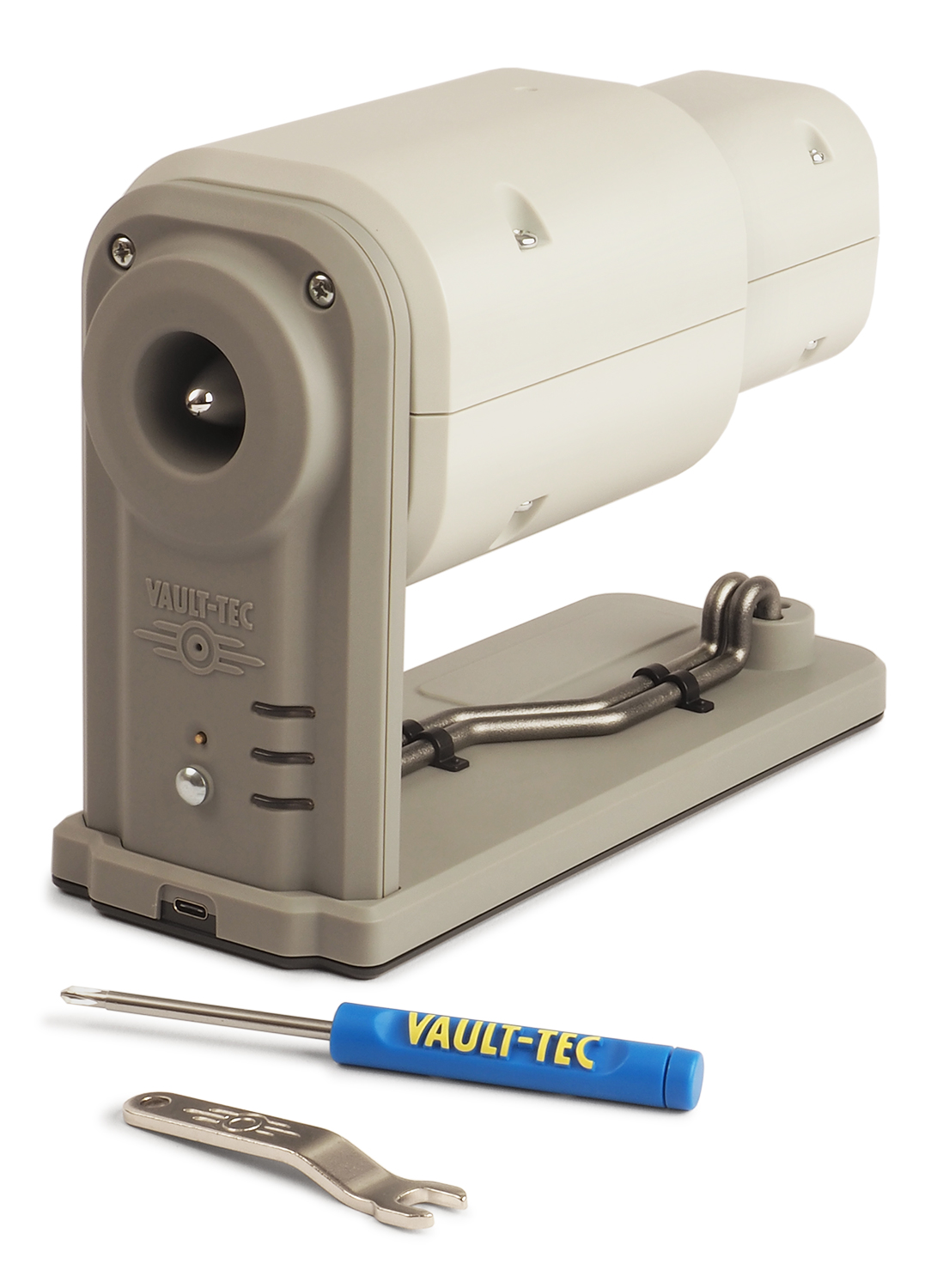
Introduction
The Pip-Boy Stand Bluetooth Speaker Kit is a faithful replica of the Pip-Boy stand created by RobCo for Vault-Tec that was routinely installed as part of a vault’s standard service equipment. The specially-designed stands ensured that Pip-Boys were stored in convenient locations within each vault, easily accessible to vault-dwellers that needed them.
For the vault-dweller who wants an enjoyable task to take their mind off the post-apocalyptic desolation of the Wasteland, who has an hour or so to kill and fancies a bit of audio entertainment to lighten the mood in their camp, RobCo presents this Pip-Boy Stand as a self-assembly kit, ready to be constructed, with added music-playing functionality via its advanced Bluetooth module.
The Pip-Boy Stand replica also includes a high-quality MEMS microphone so it can also be used as a handsfree speakerphone when paired with a suitable mobile phone. Impress camp mates with your speaker building skills and discover its 10 authentic Overseer comments, each playable at the touch of a button. Finally, and of course most importantly, display your Pip-Boy 2000 Mk VI with pride in the way it was always meant to be.
VERY IMPORTANT: Please note that the Speaker is very delicate and must be handled with care to avoid damaging the speaker cone. It has a strong magnet and it should not be placed on any magnetic media or on top of any credit or debit cards with a magnetic stripe. Take care not to let screws and other steel objects become attracted to the magnet. Insert the Speaker into the Sound Tube with great care and, before the protective grille is in place, take care not to poke or damage the front of the speaker cone.
Construction steps
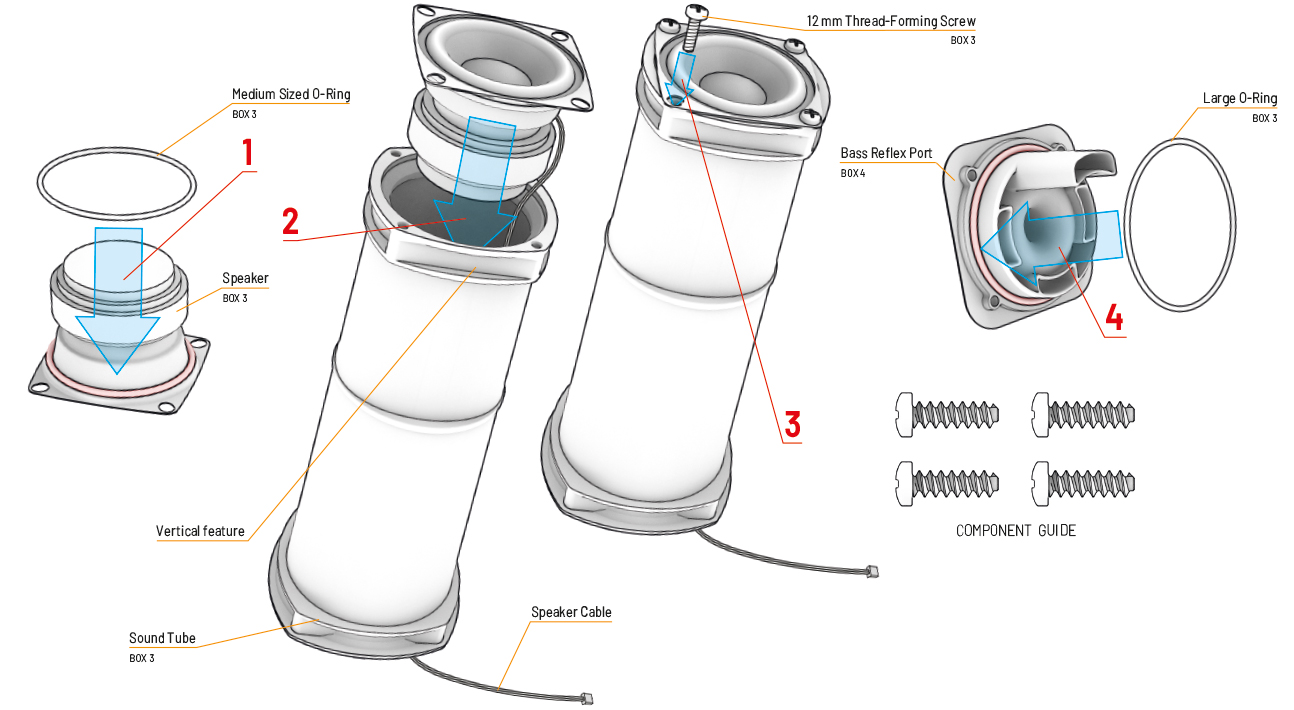
- Fit the Medium-Sized O-Ring on to the back of the Speaker.
- Handling the Speaker with care holding only the metal rim, insert the Speaker into the Sound Tube carefully passing the Speaker Cable all the way through the Sound Tube. Note the orientation of the tube by looking at the two vertical tube features.
IMPORTANT: Make sure to align Speaker connection terminals when inserting it in face of the Speaker Tube. Note the orientation of the Vertical Features with respect to the cable. The Speaker Cable should run along what will be the bottom of the Speaker Tube.
- Screw the Speaker into place in the end of the Sound Tube using the four 12 mm Thread-forming Screws.
IMPORTANT: When screwing the Speaker into position be VERY careful not to slip with the Screwdriver and poke the screwdriver tip through the speaker cone as this will cause significant damage to the Speaker and impair its performance.
- Slide the Large O-Ring on to the back of the Bass Reflex Port.
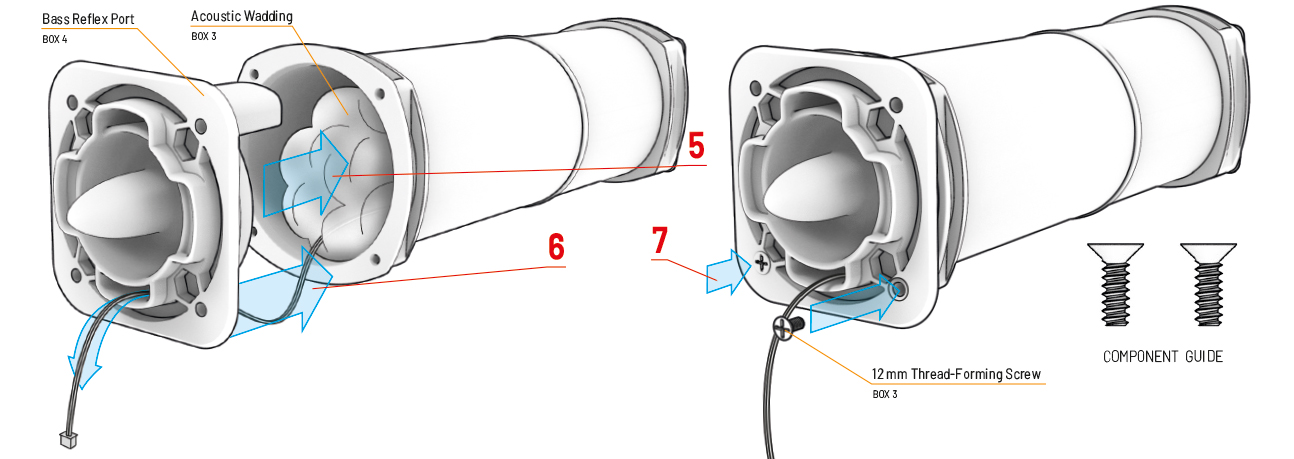
- Stuff Acoustic Wadding into Sound Tube.
- Assemble the Bass Reflex Port on to the Sound Tube so the long bass reflex opening tube is at the top, taking care to thread the Speaker Cable through the short opening in bottom of the Bass Reflex Port.
- Screw the two 12 mm Thread-Forming Screws into the lower holes of the Bass Reflex Port to secure the port to the Sound Tube.
IMPORTANT: The Lower and Upper Main Housing parts look very similar, but must be put together the right way round. The Lower Main Housing has two dots inside the moulding to easily distinguish it from the Upper Main Housing, which only has one dot inside the moulding.
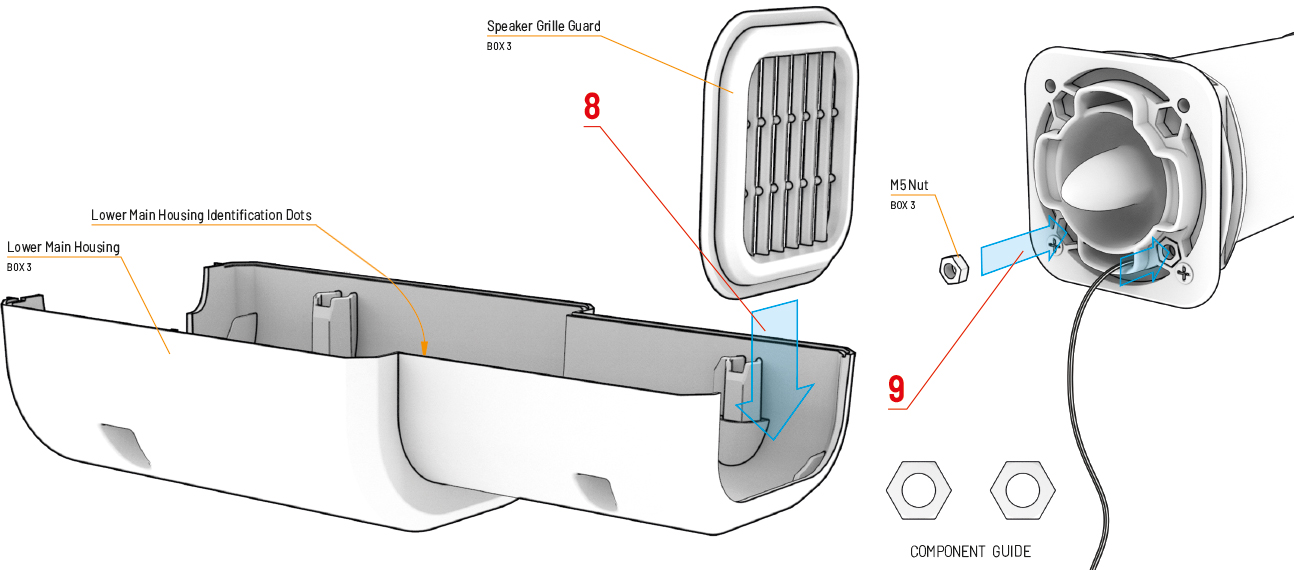
- Insert the Speaker Grille Guard into the Lower Main Housing so that the outer bars of the grille are vertical.
- Push two of the M5 Nuts into the lower hexagonal recesses in the Bass Reflex Port front face.
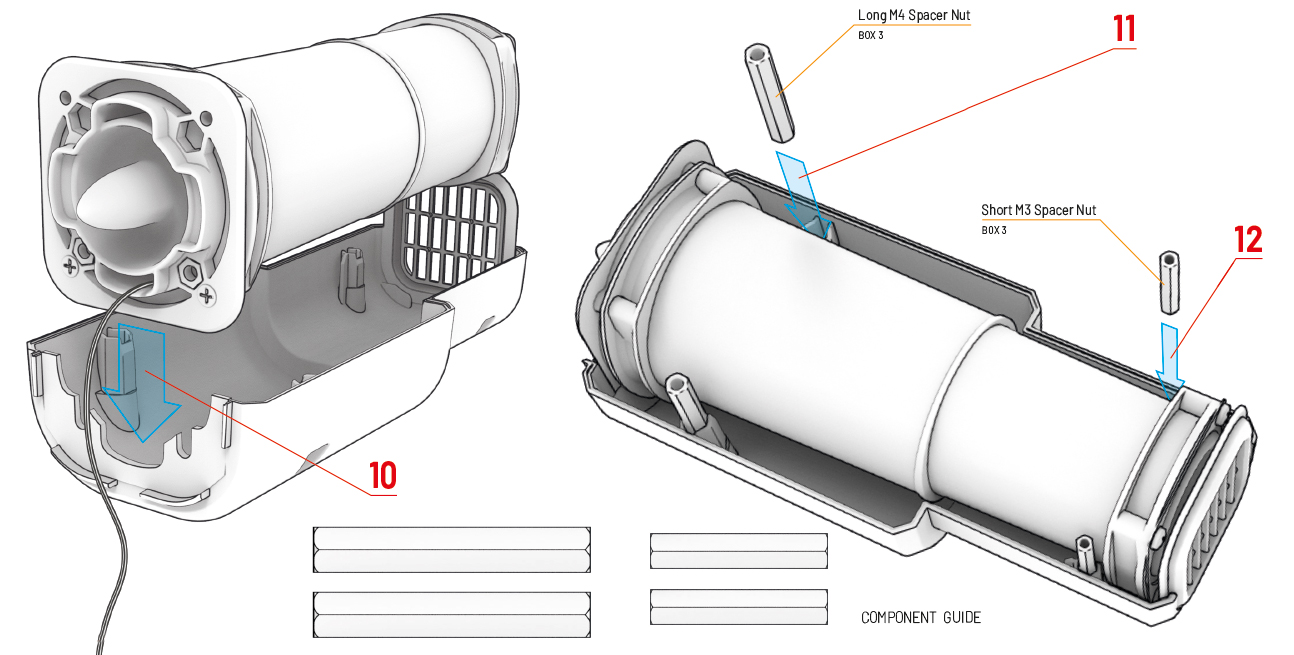
- Fit the Speaker Tube Assembly into Lower Main Housing.
- Insert the Long M4 Spacer Nuts into their respective slots at the Bass Reflex Port end of the Lower Main Housing.
- Insert the Short M3 Spacer Nuts into their respective slots at the Speaker end of the Lower Main Housing.
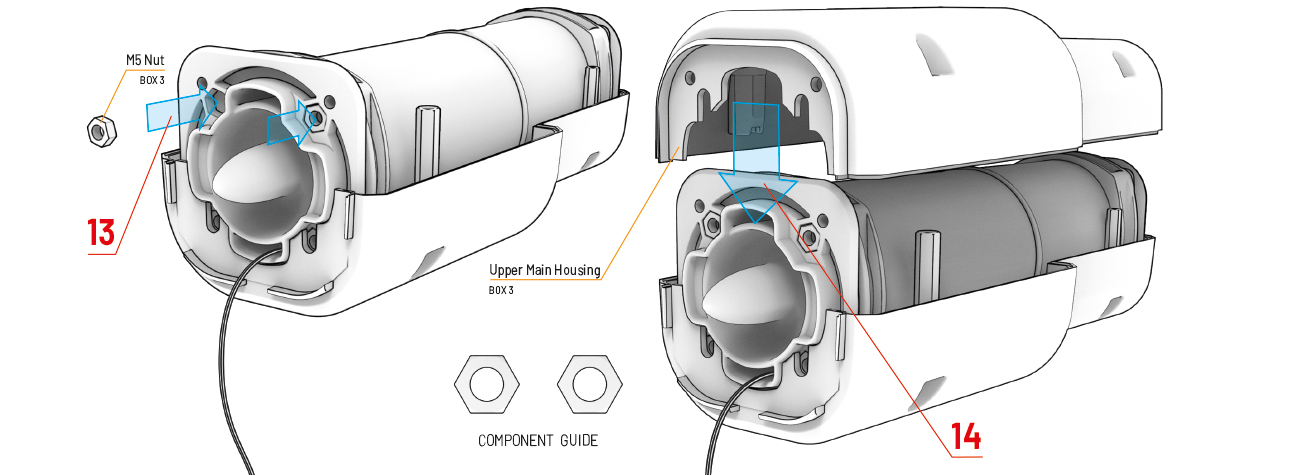
- Push two of the M5 Nuts into the upper hexagonal recesses in Bass Reflex Port front face.
- Assemble Upper Main Housing onto the Lower Main Housing ensuring all the parts align correctly.
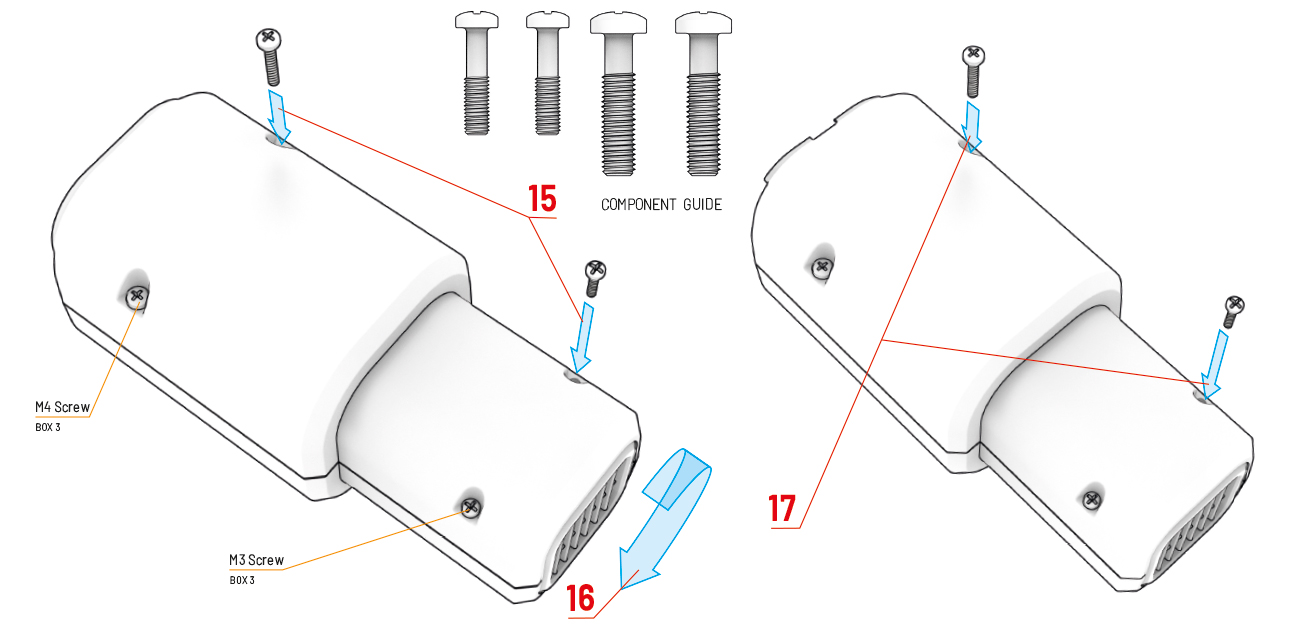
- Screw in two of the M4 Screws into the holes at the Base Reflex Port end of the Main Upper Housing. Screw in two of the M3 Screws into the holes at the Speaker end of the Upper Main Housing.
IMPORTANT: Please note that tightening these screws just fixes the Hex Spacer Nuts in place in the Upper Main Housing. As a result, the two halves of the Main Housing are not yet screwed together. You will have to turn the Main Housing over and fit four more screws before the two halves of the Main Housing are screwed together. As you turn over the assembly please take care to hold the two parts of the Main Housing firmly together.
- Turn the Main Housing Assembly over taking care to hold the two case halves together.
- Screw two M4 Screws into the holes at the Base Reflex Port end of the Lower Main Housing. Screw two M3 Screws into the holes at the Speaker end of the Lower Main Housing.
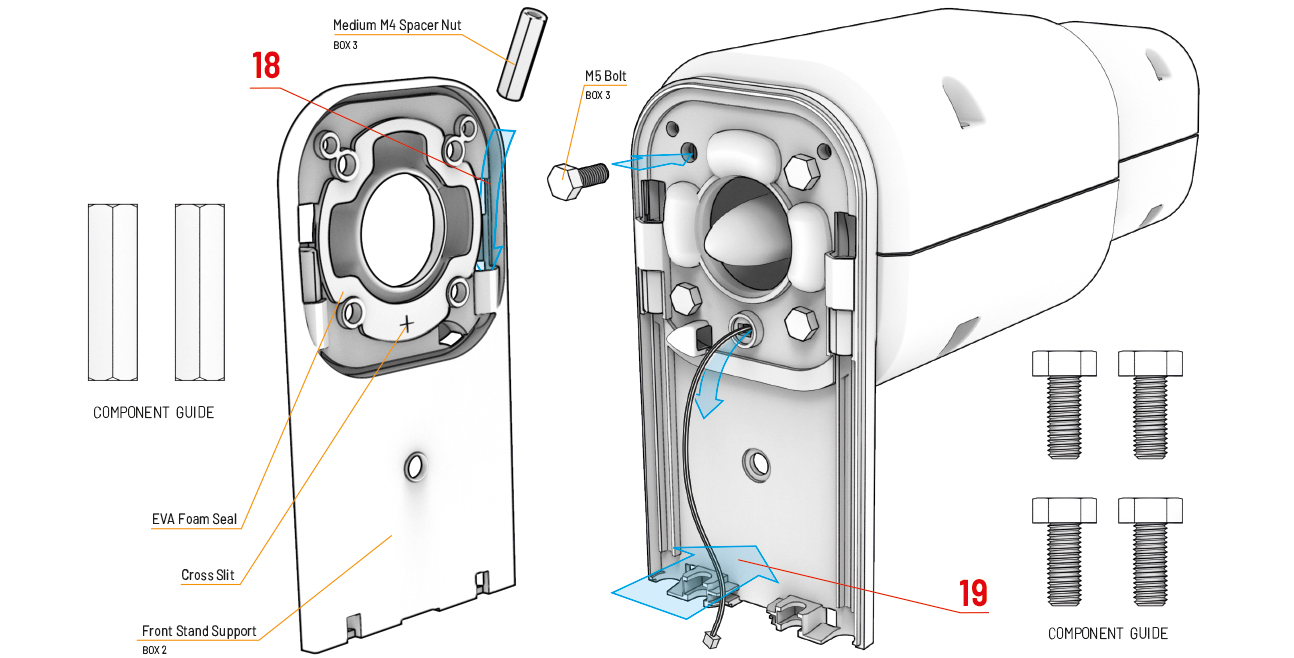
- Insert two Medium M4 Spacer Nuts into their slots each side of the Front Stand Support Cover, so that they push into position, taking care that they locate properly and don’t fall through.
IMPORTANT: The M5 Bolts that secure the Front Stand Support to the Main Housing are very close to the Bass Reflex Port features. Tighten the bolts carefully, relocating the spanner after each quarter turn.
- Hold the Front Stand Support near to the Main Housing and poke the Speaker Cable and Plug through the Cross Slit in the Foam Seal and gently pull the Speaker Cable through. Do not over-pull the cable, otherwise you might strain its connection to the Speaker. Then locate the Front Stand Support to the Main Housing and secure in position with four M5 Bolts using the Vault-Tec Spanner provided.
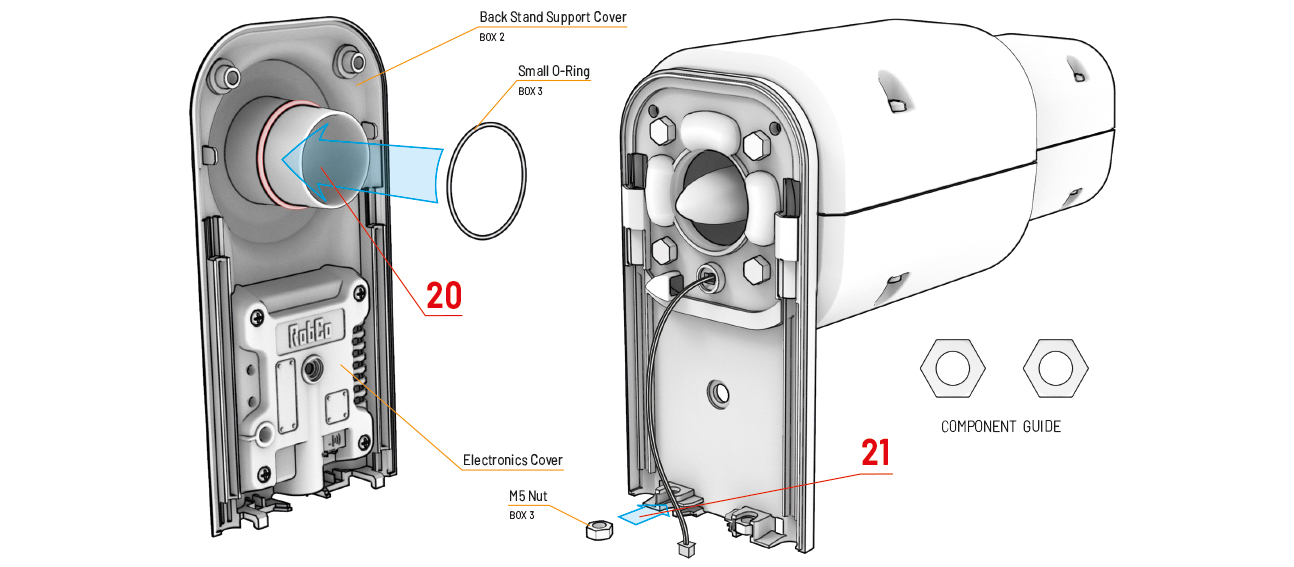
- Place Small O-Ring over the Bass Reflex Port Tube in Back Stand Support Cover up to the ridge.
IMPORTANT: DO NOT remove the RobCo Electronics Cover. Bluetooth© electronics are complex and sensitive to static shock. Removing the cover will damage the electronics and void your warranty. There are no user-modifiable parts under the cover.
- Insert the two remaining M5 Nuts into the matching recesses at the bottom of the inside of the Front Stand Support.
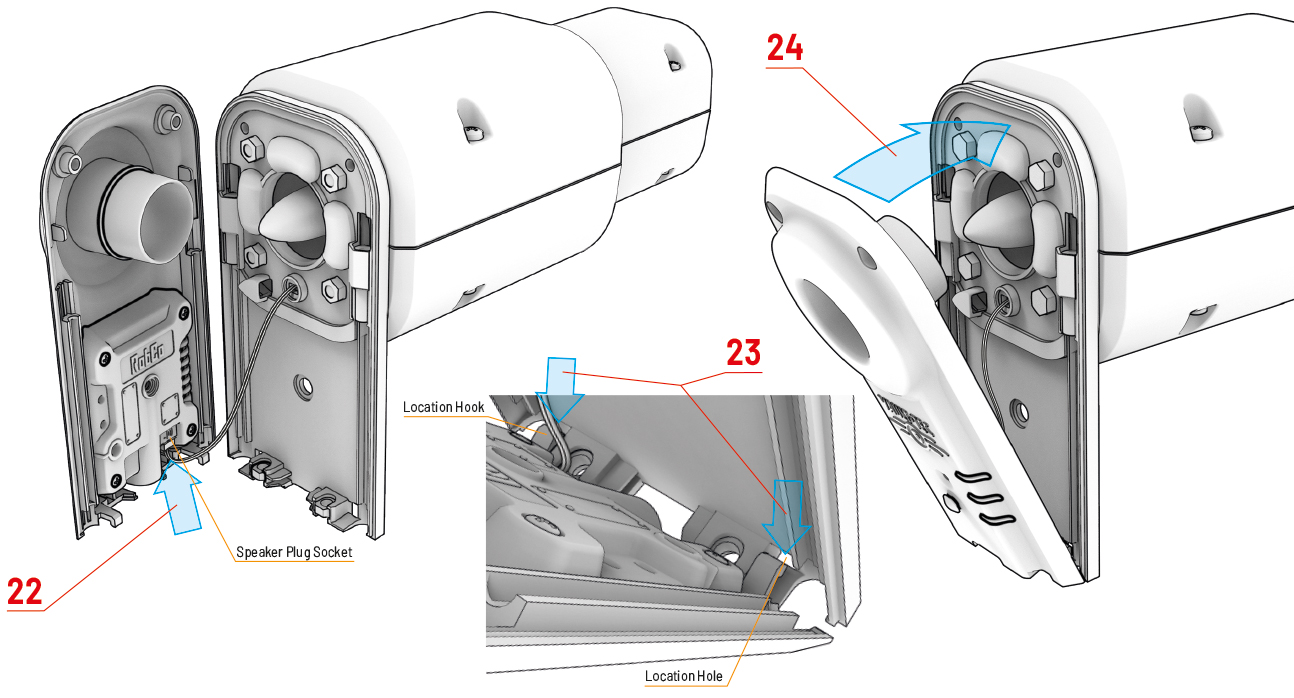
- Position Back Stand Support Cover near the Main Housing Assembly and plug the Speaker Plug into the Speaker Plug Socket at the bottom of the inside of the Back Stand Support Cover.
- Slot the Location Hooks at the base of the Back Stand Support Cover into the location holes at the base of the Front Stand Support.
- Rotate Back Stand Support Cover into position so that it fits squarely onto the back of the Front Stand Support, ensuring that the Speaker Cable lays neatly down the center of the gap between the front of the RobCo Electronics Cover and the back of the Front Stand Support.
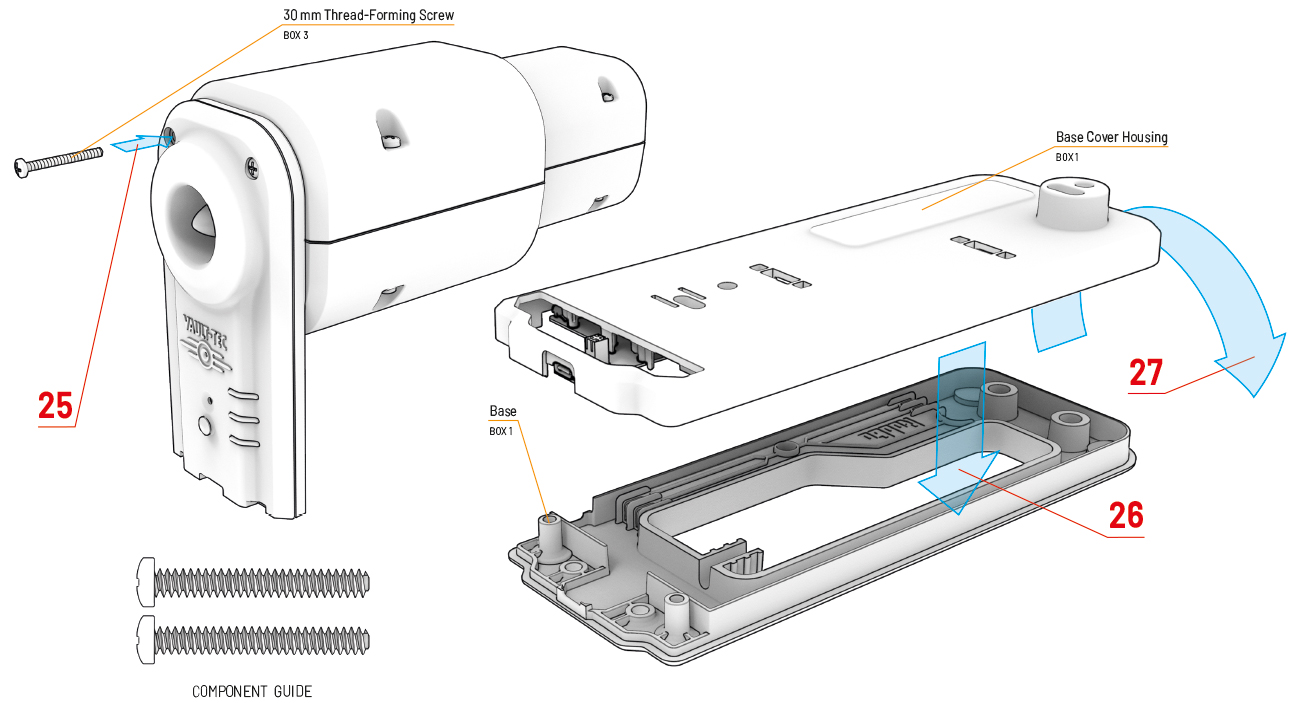
- Screw the two 30 mm Screws into the top of the Back Stand Support Cover to fix the cover firmly to the Main Housing.
- Assemble the Base Cover Housing on to the Base.
- Turn Base Assembly over.
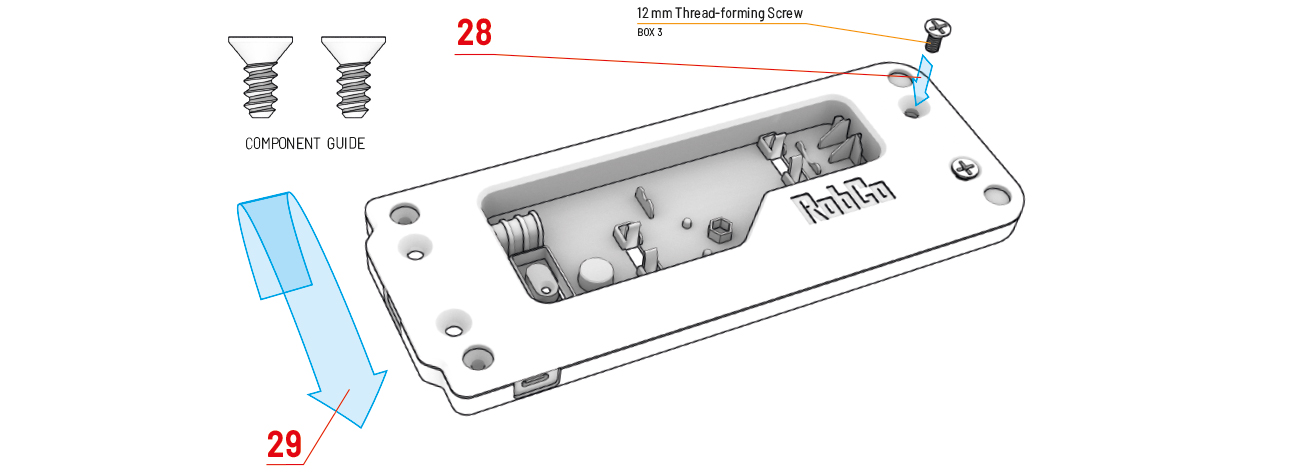
IMPORTANT: When screwing the top and bottom parts of the Base together, two different types of screw are used. There are two M5 Machine Screws and two 12 mm Thread-forming Screws. They appear to be very similar, but look carefully at the screws and note the difference. The M5 Machine Screws have a smaller pitched thread and the screw shank is slightly thicker; please note that these are for use at Support Stand end of the Base. The 12 mm Thread-forming Screws have a more angled thread and a more open pitch; these screws are for use at the Speaker end of the Base.
- Screw the two 12 mm Thread Forming Screws into the front two holes at what will be the Speaker end of the Base.
- Turn Base Assembly over.
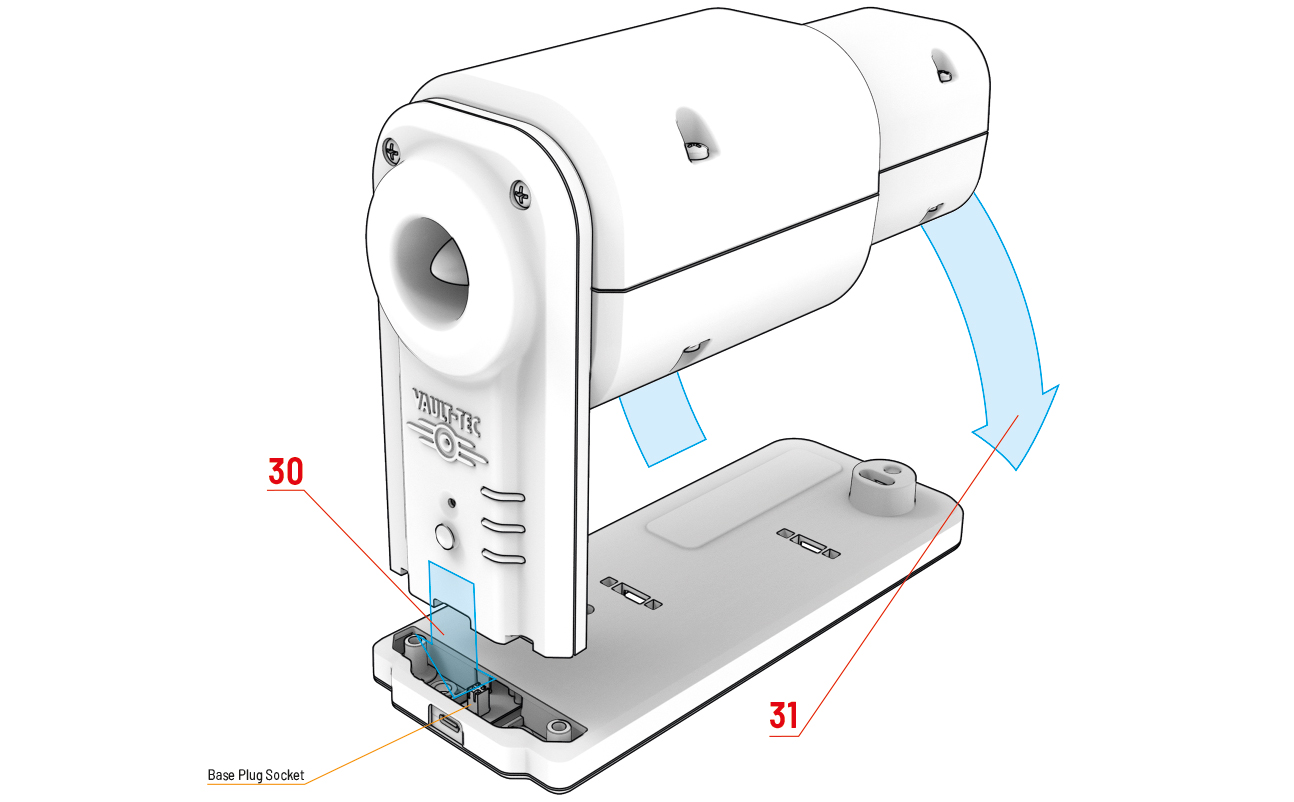
- Carefully push the Speaker Tube Stand Support Assembly into place in the top of the Base, making sure that the main electronics Connector Plug Pins engage in the Base Plug Socket.
- Once the two subassemblies are fitted together, being careful not to flex the assembly, turn it over.
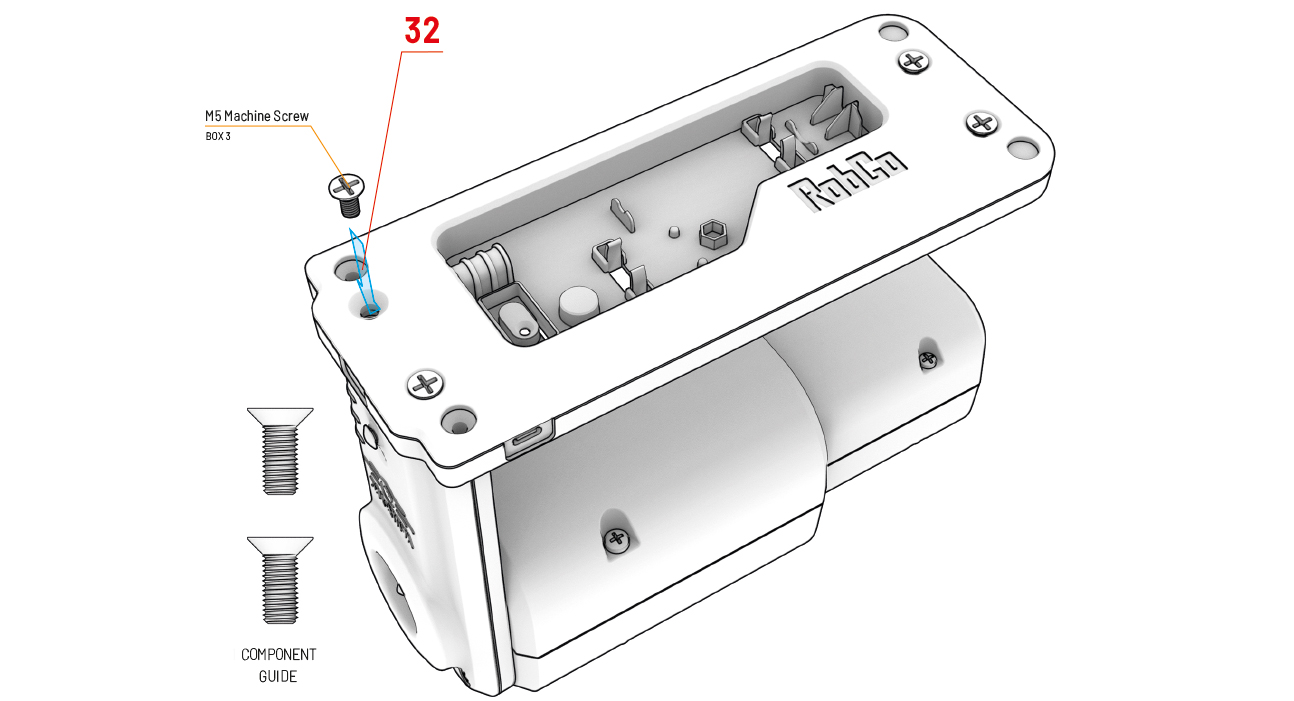
- Screw the two M5 Machine Screws into the captive nuts at the Support Stand end of the Base underside.
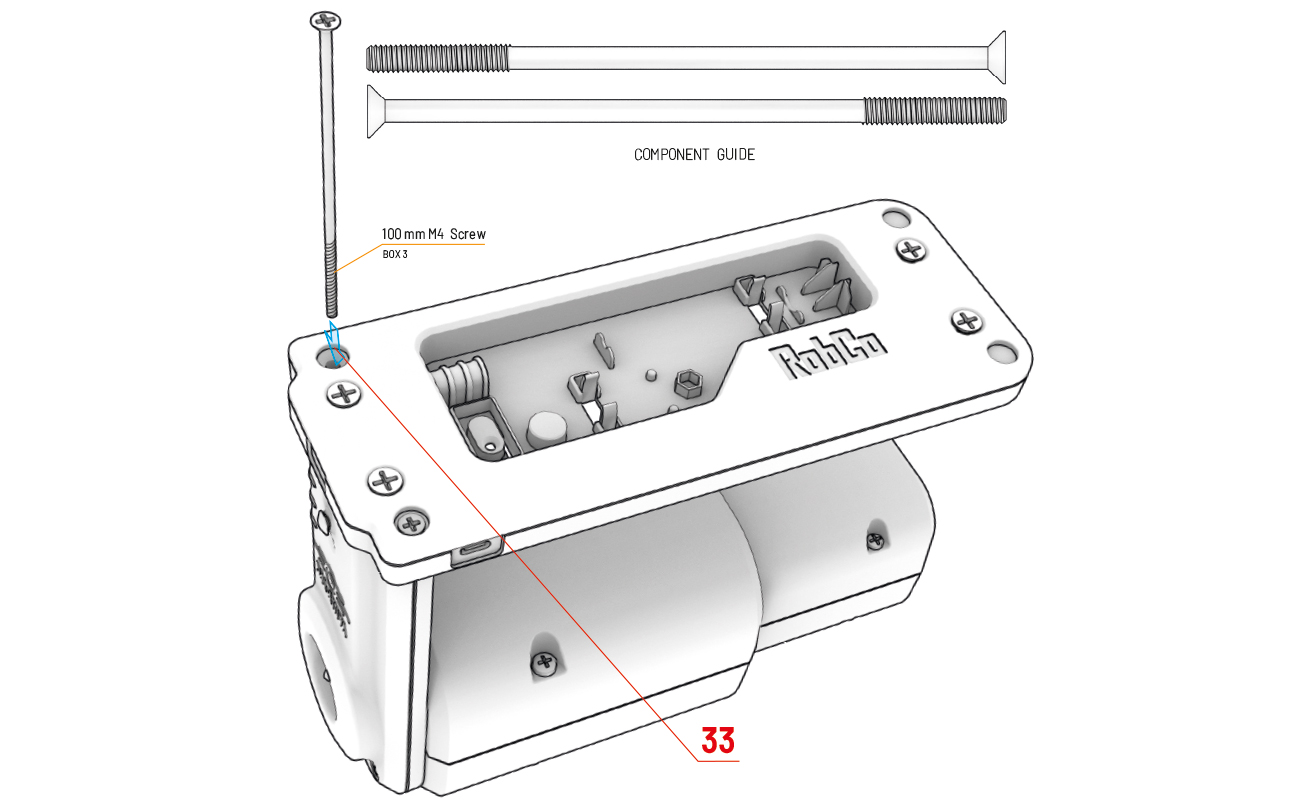
- Screw two 100 mm M4 Screws through the Base into the Support Stand and tighten to secure the Base to the Main Assembly. Note: be careful not to overtighten the 100 mm M4 Screws, as this will not make the Stand stronger and may distort the Support Stand assembly.
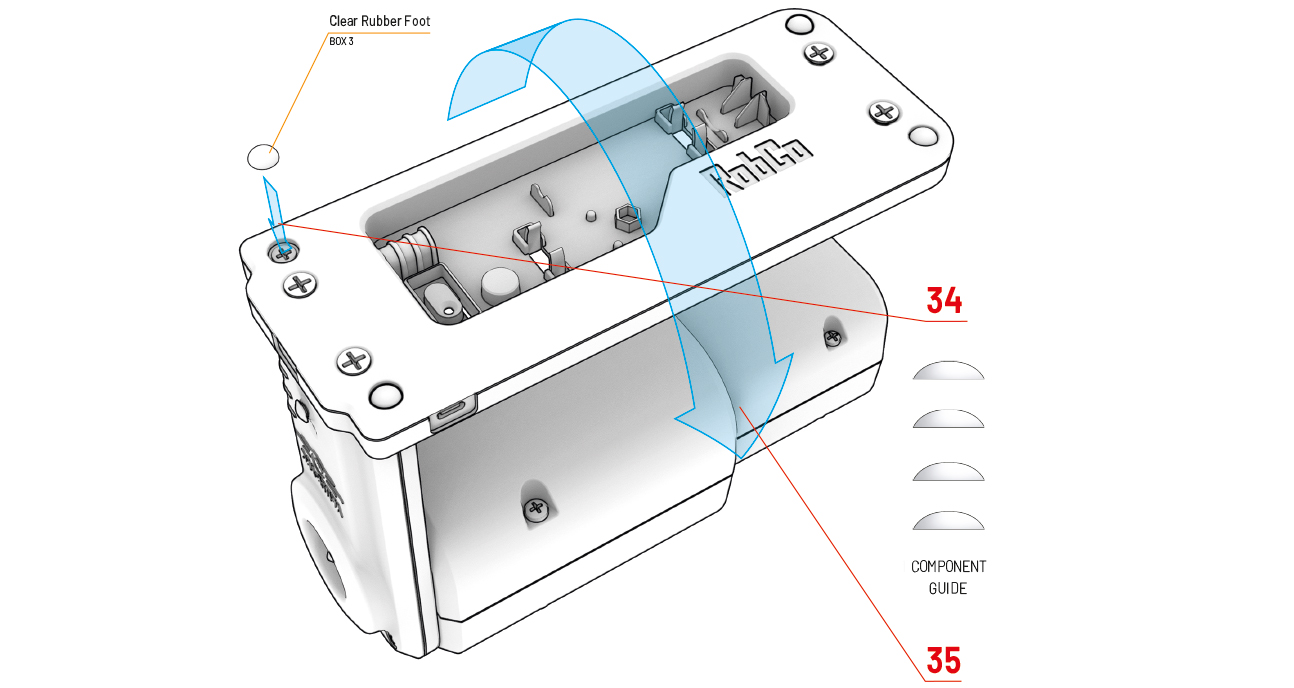
- Stick the four Clear Rubber Feet into position on the underside of the Base. At the Speaker end of the Base, the Clear Rubber Feet fit into the two blind recesses. At the Support Stand end the Clear Rubber Feet fit over the recessed M5 Machine Screw heads.
- Turn the Assembly over.
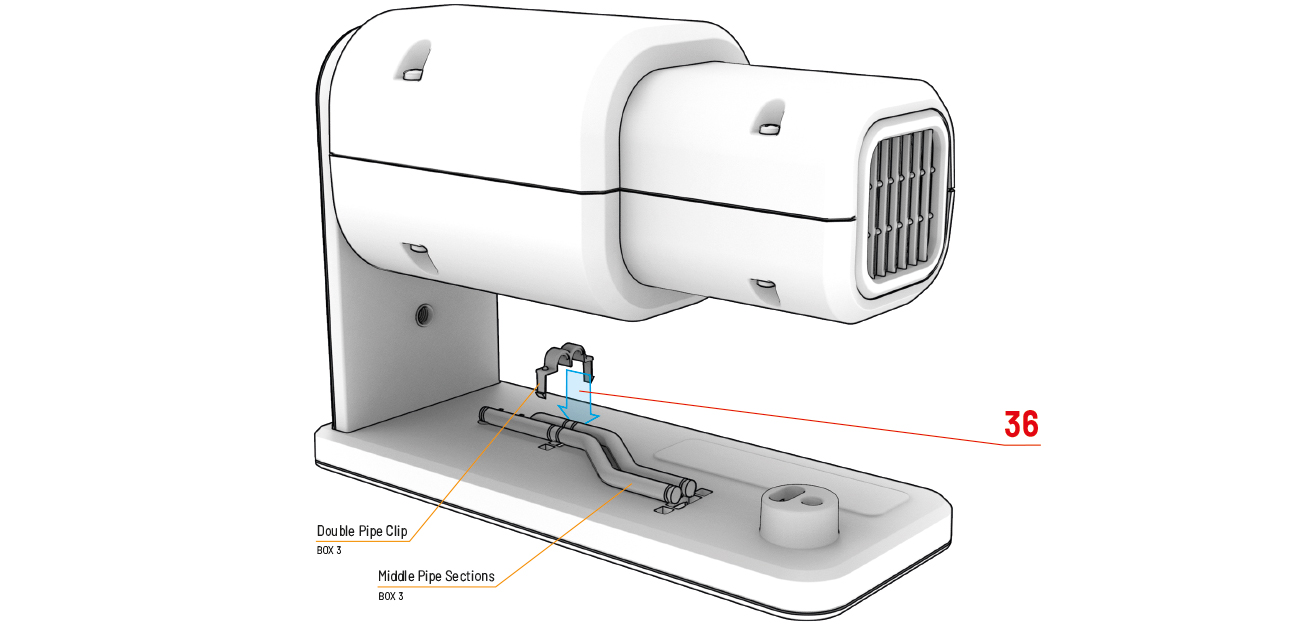
- Place the two Middle Pipe Sections into position on top of the Base and clip into place with one of the Double Pipe Clips.
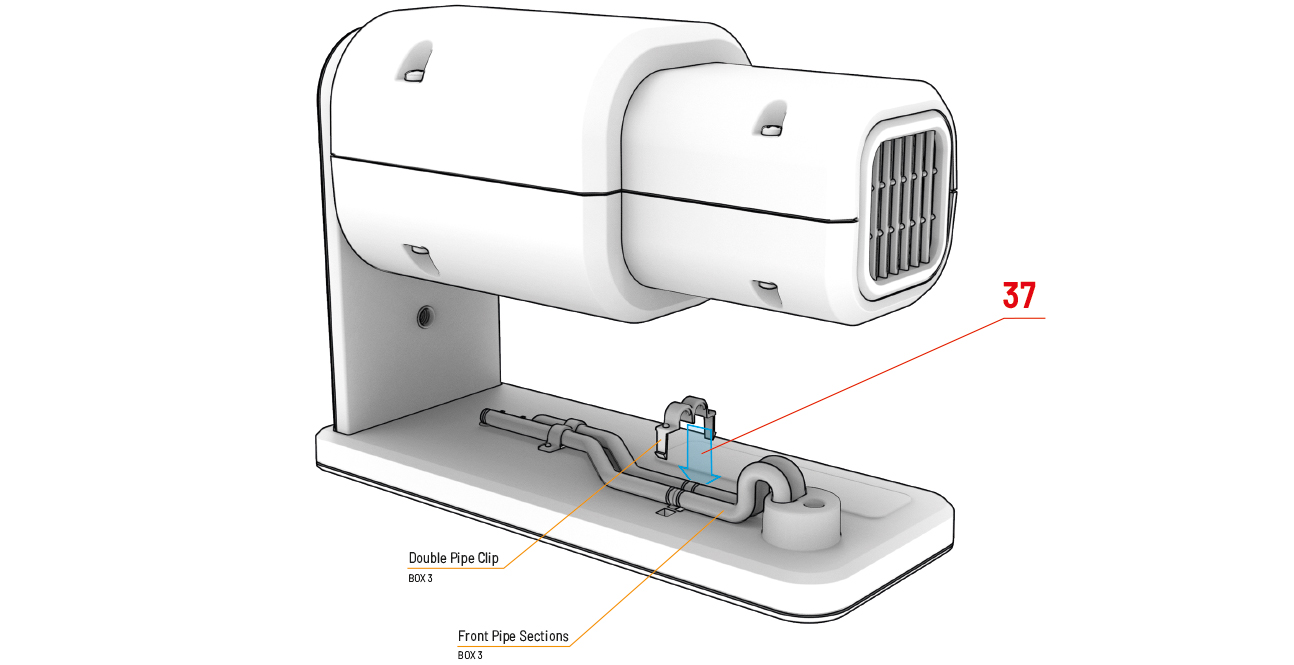
- Place the two Front Pipe Sections into position on top of the Base and clip into place with the other Double Pipe Clip.
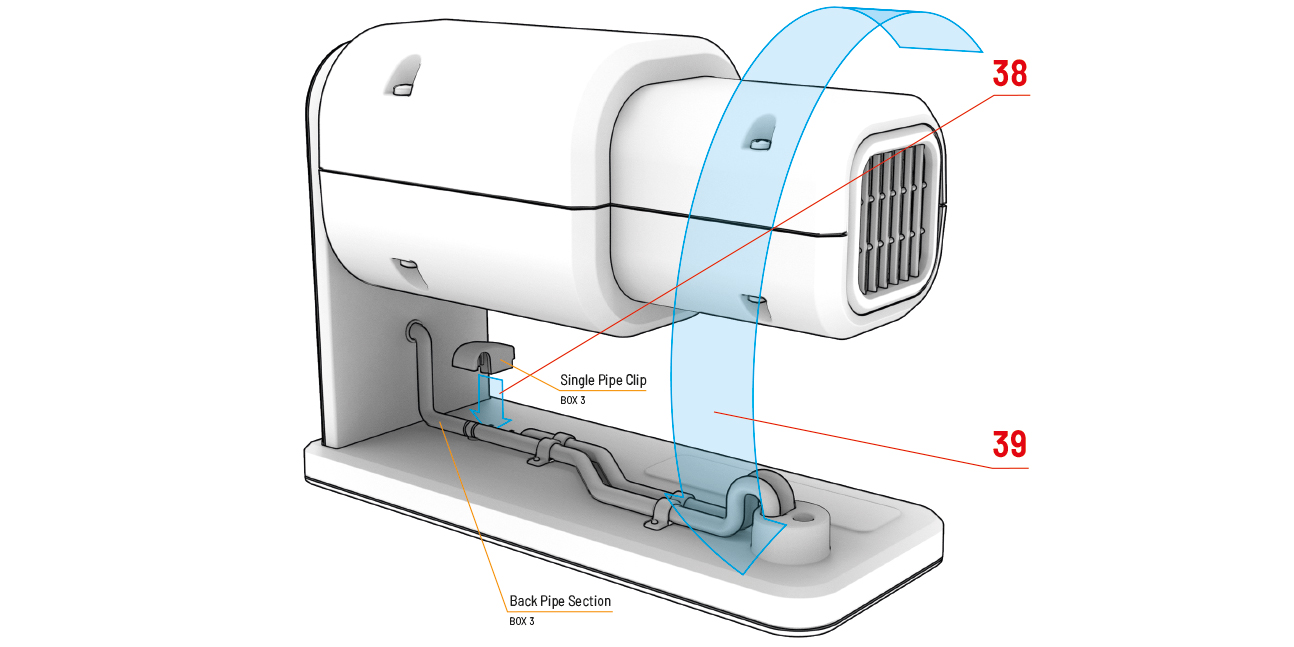
- Position the Back Pipe Section so that the short end is inserted into the matching hole in the Front Support Stand and the long end aligns with the correct one of the Middle Pipe Sections so that the pipe appears to run in a straight line and clip into place with the Single Pipe Clip.
- Turn the Assembly over.
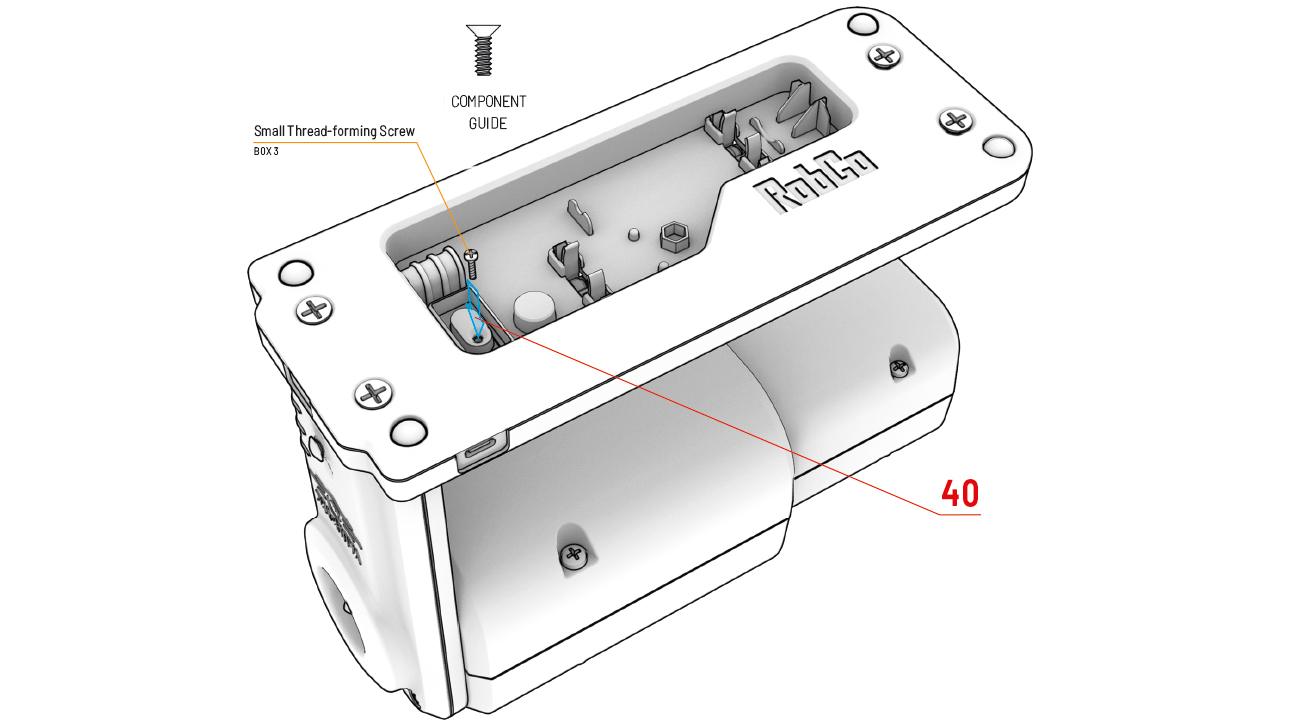
- Screw the Small Thread- forming Screw through the underside of the Base to secure the Large Single Pipe Clip.
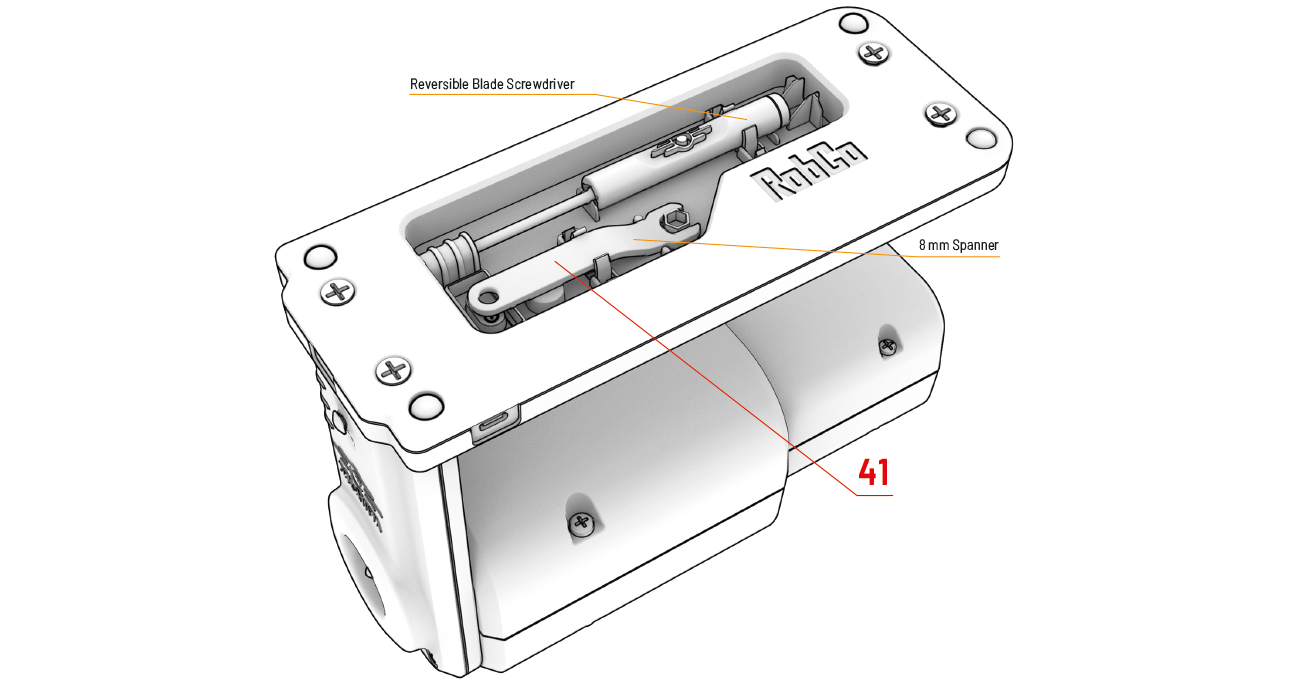
- Store the Vault-Tec Tools in the underside of the base, ready for future use. To avoid the Screwdriver becoming falling out of the Base, rotate it so that the Vault-Tec logo or the word Vault-Tec is showing, thus allowing the handle clips to grip the screwdriver securely.
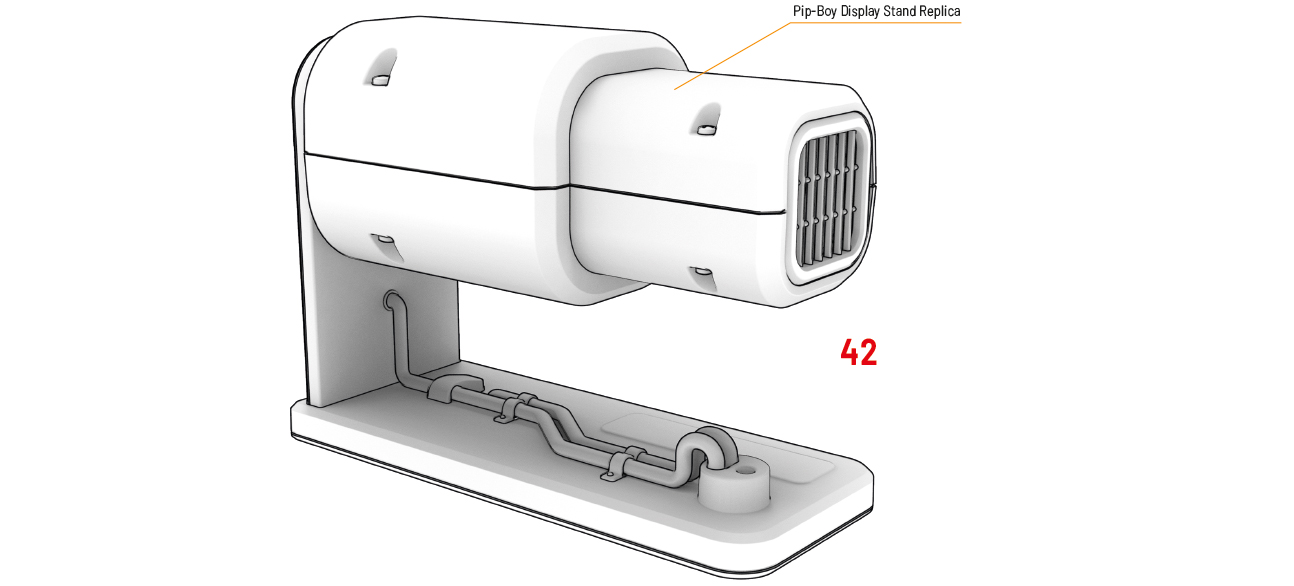
- Relax, because you have just successfully built your own Bluetooth Speaker that will not only connect wirelessly to your mobile phone or suitable music player but is a totally accurate replica of the Pip-Boy stand as seen in Vault-Tec vaults across the land. Display your Pip-Boy, play your music, answer calls and use as a handsfree speakerphone and enjoy.
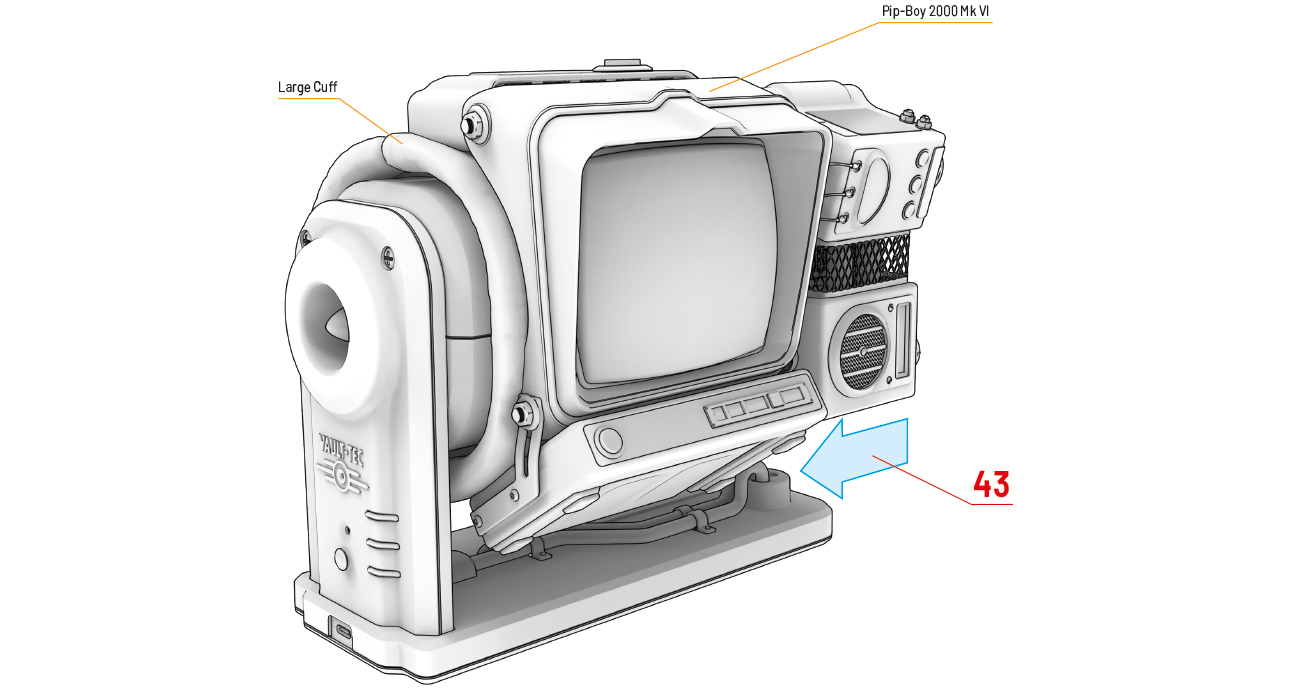
- Don’t relax for too long, because it’s time to display your Pip-Boy 2000 Mk VI. Carefully slide the Pip-boy into place fully on to the Display Stand so that the Large Cuff is at the support end and rotate so that the screen is vertical.
Operating instructions
POWERING UP AND POWERING DOWN
To power up the stand, connect the USB-C lead to a suitable power supply and plug it into either of the two USB-C Sockets on the base of the Stand. When the Stand is powered up and is not connected with another Bluetooth device, the Top Indicator flashes green. When the Stand is connected with another Bluetooth device, the Bottom Indicator double-flashes blue.
Press and hold the Power Button to power down or power up the Stand when the USB-C lead is plugged in.
JOG BUTTON FUNCTIONALITY
The Jog Button is a five-way jog button and can be either pressed in or jogged up, down, left or right. The Stand does not have to be paired with or connected to any devices if you only want to play any of the 10 built-in Overseer voice clips. Press or double press, or jog left, right or up or down or double jog in each direction to play each of the clips.
CONNECTING AND PAIRING THE STAND
In order for the Stand to play music, it must be paired with and connected to a Bluetooth-enabled music streaming device. When paired with a mobile phone, the Stand can also act as a handsfree speakerphone.
To pair and connect the Stand:
- Activate Bluetooth on your music streaming device.
- Press and hold the Jog Button until the Stand says, “Waiting for Bluetooth connection”, and the Bottom and Top Indicators alternately flash green and blue.
- Make sure your music streaming device is searching for devices.
- Within 60 Seconds, your music streaming device should show Pip-Boy Stand in its list of available devices.
- Select Pip-Boy Stand from the list.
- Your music streaming device should report that it is pairing.
- Once the Stand is paired it will emit a short high-pitched tone and say, “Connected”.
- The Bottom Indicator will double flash blue while the Stand is connected.
Typically the Stand’s Bluetooth radio will work with a range of up to five metres. Atmospheric conditions and dense solid objects (such as walls) can reduce this range. If the music streaming device moves out of range of the Stand, then the connection will be broken. However, the Stand and the music streaming device will not forget their pairing and as soon as they move back within range of each other they will automatically reconnect.
Once the Stand is paired with a device, it will remember that device and the device will remember the Stand. Each time it is powered on and the other device is within range, it should automatically reconnect to the paired device and say, “Connected”. If a paired device does not automatically reconnect, single-click the Stand’s Jog Button.
PLAYING MUSIC
To play music, double-click the Jog Button. If music doesn’t start playing automatically, browse to the music on your music player and select play. Once the music is playing through the Stand, double-clicking the Jog Button will pause or play the music.
While playing music, the Jog Button’s functions are altered slightly. Instead of voice clips, jog right and jog left will skip tracks forward and back respectively.
VOLUME CONTROL
Whilst paired, the volume of the Stand’s speaker may be adjusted by holding the Jog Button up or down. A low beep is played for each volume step and a higher beep is heard when the volume is at its maximum or minimum setting.
NOTE: Depending on the paired device, adjusting the music playback volume on the paired device may affect the volume of the music streaming through the Stand.
UNPAIRING
To unpair the Stand from a device that it has been paired with, browse to the device’s Bluetooth settings menu, select Pip-Boy Stand from the paired devices list and select “unpair” or “forget”.
NOTE: The exact sequence for unpairing will vary from device to device, so please consult your device’s manual for the correct procedure.
CARE INSTRUCTIONS
The Stand is a high tech communications device and should be handled with care. Clean only with a soft, slightly damp cloth and never immerse in water.
To protect the Stand while not on display, store it out of direct sunlight. The Stand should only be used when its operating temperature is between 10˚C and 40˚C (50˚F to 100˚F).
